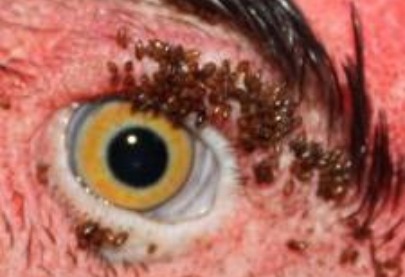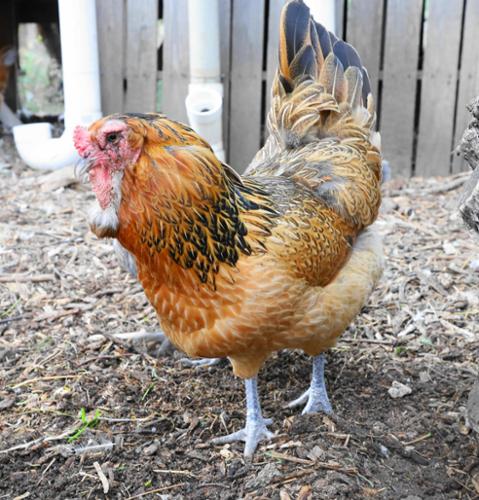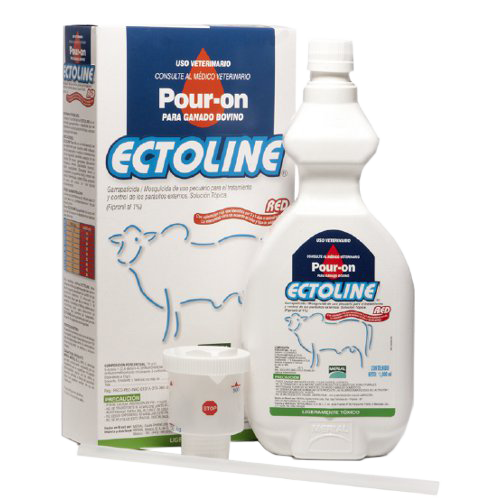Stick Tight Fleas
May 25, 2022

Fleas have been horrible here in Texas and more and more people are dealing with a poultry flea called Sitcktight Fleas. These horrible creatures are ectoparasites that, as adults, embed themselves into the skin of chickens, turkeys, and other animals. Sticktight fleas are most common in free-range and backyard poultry systems. Immature fleas require organic substrate in the litter or soil to develop so we don't see these fleas in caged-bird systems.
Sticktight flea adults look like most other fleas. They are dark brown and laterally flattened. What makes these different is adult sticktight fleas embed themselves in the bare skin on the head of poultry, using their elongated mouthparts to stay in place, unlike the more common cat or dog fleas. They can also be found on other hosts such as squirrels, dogs, cats, foxes, or even people. Though infestation of humans is uncommon, that does not mean they will not take advantage of a human host. While attached to the host, females lay their eggs which fall to the litter or soil. Larvae hatch and live on organic material and digested blood from adult fleas in the litter/soil. When ready to pupate, the immature will form a cocoon of silk and dust to pupate within. Emerging adults have powerful jumping legs and acquire new hosts as these animals wander by. The life cycle from egg to adult takes about one month to complete.
These pests can can cause irritation to their host and blood loss. With poultry you see constant head shaking and scratching. A few fleas are difficult to notice. But as the number grow, you will see dark areas around the eyes and ears of the bird. Closer examination will show the fleas embedded in the skin in large clusters on the birds head. If infestation is severe it can lead to anemia or even death. Skin gets thick and scarred with a large parasite load. Though Sticktight fleas are not known to be important vectors of disease, they will make the host absolutely miserable with their constant biting.
We have been dealing with these bloodsuckers off and on for a while. We would spray the yard and spray the birds with a flea spray used on dogs and cats. While this approach gave me periods of time where the irritation was minor, they never went completely away. We had heavy and light cycles of infestation until finally, they were out of control. I got fed up with coming in the house infested with fleas crawling and biting me everywhere and knew I needed to take some serious action. They also caused my dog a lot of pain and irritation as he scratched and chewed his skin raw non stop to get rid of them. It was time to take a different approach and make getting rid of these things a priority.
I was using Permethrin that I purchased at a local Tractor Supply. I mixed the pesticide in a sprayer, hooked the sprayer to a hose, and sprayed my backyard. Permethrin will readily kill fleas within a short period of contact all the while being largely non-toxic to humans. It works by causing dysfunction or by over exciting the nervous system. When fleas come in contact with permethrin, the chemical causes dysfunction or over excites the nervous system. This sets off conflicting bodily signals that eventually kill the fleas. Not only will permethrin kill fleas, it also exterminates other pests such as mosquitoes, spides, chiggers, mites, flies, ticks, gnats, biting flies, black flies and several others.
I absolutely hate using any kind of chemical, especially for bug control, in the yard as there are good bugs as well as bad. But I was pushed to taking some drastic measures because of the sheer numbers that needed controlled. With the Pyrethrin I would spray the yard and around the pens, and in time, get some knockdown. Pyrethrin is a synthetic version of pyrethrin found in pyrethrum plants. Pyrethrin is naturally occurring in such plants and provides protection from insect pests. Initially when I started, I expected an immediate knockdown and death when I sprayed so was very disappointed when it did not happen. I discovered later that it can take several days for the fleas to start dying off after the application to the yard. The Permethrin should kill the adult fleas for at least 10 days after application. Bear in mind this is only killing the adults. There is still about 80% of the flea population left unharmed and populations will continue to hatch and grow. This is one area where I had problems and why I always seemed to have some number of fleas around. I needed to be spraying about every other week to be killing off the new generation that was hatching out.
I am going to be honest.. I spent about two years trying all kinds of things to get rid of these evil creatures. Even our Snowmeggedon even here in Texas in 2021 did not kill them off. When the spray seemed to not be working I tried a granule that was to be watered in. I had heard it was great flea control in kennels, but it never did anything to reduce my poultry flea population. I also sprayed an insect growth regulator that also did not seem to make much of a dent. All the while I was spraying the yard, my birds were dealing with the infestation on their bodies as well. They would get a flea load noticeable around the head and neck and I would catch them and spray them with a dog/cat flea spray to kill off the fleas. As much as I tried to keep them sprayed, I never could get rid of all the fleas and the birds were just miserable.
In desperation I got yet another spray because what I had was not working. The yard was so heavily infested I could not step outside without getting attacked by fleas. So I went out and started spraying without really reading the precautions. I also was not paying attention to the weather. We tend to always have a decent breeze here.. where we get the Windy part of our name, but it was very windy the day I sprayed and I was not watching the wind drift of the pesticide. My focus was on getting the spray where I had fleas jumping on me with the hopes to kill as many as possible. So I was spraying right up next to the pens and not noticing the drift took the pesticide into the pens and runs.
The day after I sprayed I came outside to dead birds everywhere. One pen of Wheaten Marans gone. The splash pen of my Silverudds Blue I lost 10 of 12 absolutely beautiful splash hens. A couple of Copper Marans girls and some young roosters we were growing out also gone. There were also some mixed breed girls that numbered among the dead as well. I was totally heartbroke and sat down and cried. I got very close to just selling the birds and nuking the backyard just to be done with the fleas. The chickens were no longer a fun pastime for me.
Then a chicken friend told me about Ectoline pour on. It is not cheap and I was given a small spray bottle with some Ectoline in it. I was told to spray up around the head on top of the fleas that were currently infesting the birds. Others, not infested, I just sprayed a little on the back above and between the wings. I was told it would take a few days to see the fleas start to drop. We sprayed several birds to check it out and I was shocked.. it really did get rid of the fleas on the birds. But, the spray I was using also got rid of the fleas for a bit so we decided to see what happened over time.
The first birds we sprayed with the Ectoline lost all the fleas that had infested them and they have stayed flea free. So we started working on getting the rest of the birds sprayed. When we moved Littles off the wire brooders and into a grow out, they got a drop or two on their backs at the base of their necks. They can be seen shaking their heads here and there as I think they are still some fleas, but they get on the birds bite and quickly die. With the fleas dying out they are not reproducing. And hopefully all the chemicals I put on the ground are also helping to reduce and wipe out the population. I still am trying to spray every other week with the Permethrin to catch the adults hopping about in the yard looking for a host.
Ectoline has fipronil, a broad-spectrum insecticide that belongs to the phenylpyrazole chemical family. Fipronil disrupts the insect central nervous system by blocking the ligand-gated ion channel of the GABA A receptor and glutamate-gated chloride (GluCl) channels. This causes hyperexcitation of contaminated insects' nerves and muscles. It is very easy to apply using a spray bottle and seems to control the fleas for a long period of time. The product is not labeled for use in poultry, but I can tell you it works. Their warnings for other animals of no less than a 2 month interval between applications and not for food consumption within 100 days of application should be followed with poultry as well. I will caution it is red in color and will stain clothes. Make sure you wash hands well when done or even wear gloves.
For the first time in years I am hopeful we are getting rid of these nasty bloodsuckers. The birds are happier and not stressed. I am able to be out with the birds, and once again, enjoy sitting with them and we are back to getting photos. I am still getting a flea here or there hopping up on me, and the dog seems to still be getting some, but the numbers are seriously reduced and I feel we will have them completely eradicated soon. I will continue to spray the Ectoline on my birds as a preventative twice a year. There are wild birds, other chickens in the neighborhood and a number of hosts they can live on to bring fleas back into the yard. After finally getting a handle on their destruction, I will not let them get a foothold on my property again.



